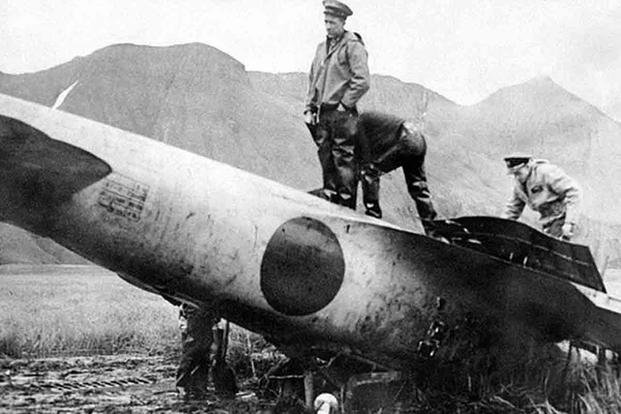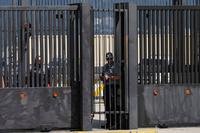At the start of World War II, Japan's Mitsubishi A6M Zero fighter was the most vaunted and feared weapon in the enemy arsenal. Lightweight and maneuverable, the Zero was able to outfly and outshoot every aircraft the Allies were flying in the early 1940s.
That all changed when Japan attacked the Aleutian Islands in Alaska. On June 3, 1942, a Japanese fleet launched a two-day aerial assault on Dutch Harbor. Having broken Japanese naval codes, the Americans knew they were on the way and put up a wall of anti-aircraft fire.
The Japanese were largely fought off, but they returned the next day. A combined force of Nakajima B5N2 "Kate" torpedo bombers and Zeros bombed and strafed Dutch Harbor. This attack was much more effective, but the American defenders took their toll on the attackers.
One of the downed Japanese airmen and his Zero would change the course of the war in the Pacific for the Allies by shattering the myth of the Zero's supremacy.
A 19-year-old flight petty officer named Tadayoshi Koga took off from the Imperial Japanese Navy carrier Ryujo to join the June 4 attack on Dutch Harbor. He and his strike group of three IJN Zeros strafed Dutch Harbor that day. Koga would never return to the Ryujo.
His Zero was hit by American anti-aircraft guns defending the harbor, cutting his oil line and causing a trail of smoke as he flew to nearby Akutan Island. It was there that he found what he thought was a placid green field in which he could land his plane, but it turned out to be a bog. When Koga lowered his landing gear, the wheels hit the mud, flipped the plane and killed the pilot.

It's not known why his wingmen didn't attempt to destroy Koga's downed plane, which was their orders for any intact Zero that might have been taken down by the Americans. Instead, they flew back to their carrier, leaving the plane relatively intact in the mud.
The reason the Japanese Navy wanted to ensure that every Zero taken down intact was destroyed was because the Zero was the preeminent fighter of the day. It could easily outmaneuver British and American planes and had a greater range than any German-made aircraft.
If anything, the Japanese Zero was the weapon that won most of Japan's early battles in World War II. If the Allies were going to beat the Japanese in the Pacific, they would need to learn everything they could about their enemy's fighter plane. An intact Zero captured by the Americans was the worst thing that could happen -- and one was sitting in an Alaskan bog undefended.
The next month, a U.S. Navy Catalina seaplane spotted the wreck on Akutan Island. When they finally made it to the island to take a closer look, they realized the intelligence coup they now had. After more than a month of multiple salvage attempts in knee-high mud, they finally got the plane out of the bog and back to San Diego's Naval Air Station North Island.
There, the Navy uncovered every secret of the Japanese Zero. It was a simple but well-made plane with easily opened maintenance plates, folding wings and a lightweight construction that gave it its range and agility in combat.
Once the Navy took it up for a test flight in September 1942, naval aviators almost instantly figured out its weaknesses. The Zero lost most of its maneuvering ability at 200 knots because the ailerons, a component of its wings that controls lateral balance, freeze up at those speeds. It also rolled more easily to the left and its carburetor forced the engine to shut off during negative acceleration. It gave the Navy a standard tactic to use against the Japanese.
When unable to escape a pursuing Zero, naval aviators could go into a vertical power dive, using negative acceleration if possible to open the range while the Zero's engine was stopped by the acceleration. At about 200 knots, they would roll hard right before the Zero pilot could get his sights lined up.
Once outmaneuvered, the unarmored Zeros were easy pickings for Allied pilots. The Navy sent the new tactic to the pilots flying in the Pacific Theater, which immediately leveled the playing field. It also sent the intelligence to Grumman Aircraft, which began designing an F6F Hellcat fighter that could meet the needs of pilots dogfighting the Zero.
The new Hellcat incorporated a new 18-cylinder engine and a redesigned airframe that increased its overall performance using this tactic. American fighter aces would later say that knowledge gleaned from the captured fighter saved their lives in combat. Adm. William Leonard, himself a fighter ace, said, "No other captured machine has ever unlocked so many secrets at a time when the need was so great."

The captured Zero was destroyed in a training accident in 1945, but the damage to the Japanese fleet was already done by then. As for Tadayoshi Koga, its original pilot, he was given a burial ceremony on Akutan Island in 1942, but his remains were moved to Adak Island after the war. In 1953, the remains of hundreds of Japanese troops were repatriated to Japan, where they were cremated.
-- Blake Stilwell can be reached at blake.stilwell@military.com. He can also be found on Twitter @blakestilwell or on Facebook.
Want to Learn More About Military Life?
Whether you're thinking of joining the military, looking for post-military careers or keeping up with military life and benefits, Military.com has you covered. Subscribe to Military.com to have military news, updates and resources delivered directly to your inbox.













